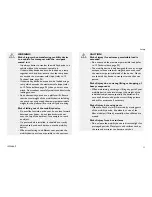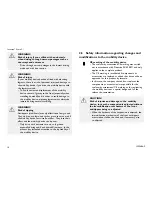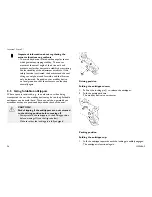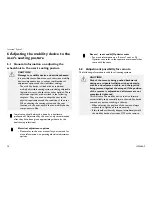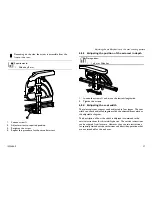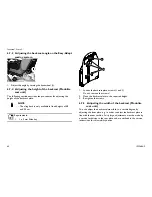
Driving
5.3.3
The correct way to overcome obstacles
Right
Wrong
Ascending
1.
Approach the obstacle or the curb slowly, head-on and at a
right angle.
2.
Depending on the wheel drive type, stop in one of the following
positions:
a.
In the case of centrally driven mobility devices: 5 - 10 cm
before the obstacle.
b.
For all other drives: approx. 30 - 50 cm in front of the
obstacle.
3.
Check the position of the front wheels. They must be in driving
direction and at right angles to the obstacle.
4.
Approach slowly and keep at a consistent speed until the rear
wheels have also passed over the obstacle.
Descending
The approach to descend an obstacle is the same as to ascend it with
the difference that you need not stop before descending.
1.
Descend the obstacle very slowly.
5.4
Driving up and down gradients
For information concerning the maximum safe slope, refer to 12
Technical data, page 95.
CAUTION!
Risk of tipping over
–
Only ever drive downhill at a maximum of 2/3 of the
top speed. Avoid sudden changes of direction or
abrupt braking when driving on slopes.
–
Always return the backrest of your seat or the seat tilt
(if adjustable seat tilt is available) to an upright position
before ascending slopes. We recommend that you
position the seat backrest or the seat tilt slightly to
the rear before descending slopes.
–
Always lower the lifter (if fitted) to its lowest position
before ascending or descending a slope.
–
Never attempt to ascend or descend a slope on
slippery surfaces or where there is a risk of skidding
(such as wet pavement, ice etc).
–
Avoid trying to get out of the vehicle on an incline
or a gradient.
–
Always drive straight in the direction the road or path
you are on goes, rather than attempting to zigzag.
–
Never attempt to turn around on an incline or a slope.
CAUTION!
Braking distance is much longer on a downhill
slope than on even terrain
–
Never drive down a slope that exceeds the maximum
safe slope (refer to 12 Technical data, page 95).
1529686-P
25

